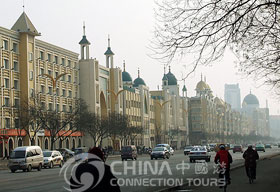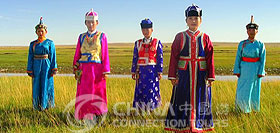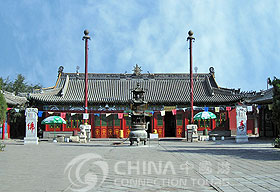 Hohhot, meaning Green City in Mongolian, is an oasis on the grasslands of the vast Tumuochuan Plain. The city is the capital of the Inner Mongolia Autonomous Region. It is a commercial and industrial center in a region of grasslands and major defense installations. The city serves as the regional hub for education and economic, scientific and technological development. It is a major textile center. Leather, sugar, machinery manufacturing, steel, and animal-product processing are other important industries in the area.
Hohhot, meaning Green City in Mongolian, is an oasis on the grasslands of the vast Tumuochuan Plain. The city is the capital of the Inner Mongolia Autonomous Region. It is a commercial and industrial center in a region of grasslands and major defense installations. The city serves as the regional hub for education and economic, scientific and technological development. It is a major textile center. Leather, sugar, machinery manufacturing, steel, and animal-product processing are other important industries in the area.
Geographical Features
The city sits upon a high, inland plateau with elevations of about 1,000 m (about 3,000 ft) above sea level. The city is bordered by the Daping Mountains to the north and faces the Dahei River to the south. On the north and west the land falls toward the vast Gobi Desert. The Huang He (Yellow River) flows north from Ningxia Hui and forms a great loop that encloses the Ordos Desert (Mu Us Shamo). The Huang He is used for irrigation and there are numerous settlements and several cities along the river's course through Inner Mongolia.
Although the range and extremes of temperatures and precipitation vary, Inner Mongolia's climate is typically dry, with warm summers and very cold, dry winters. The average January temperature in the capital Hohhot is -9C (16F); the average August temperature is 24C (75F). The annual precipitation is 368 mm (14 in). Most of the rain falls in the east of the country. In the west vegetation is sparse, while the eastern mountains are covered with coniferous forests and, at lower elevations, a few deciduous species. Grasslands predominate on the plateau, where they sustain large numbers of sheep, goats, camels, and horses.
 People
People
Hohhot is home to 2.4 million people from over 10 different minority nationality groups including the Hui, Mongolians, Manchu, Ewenki, Daur and others. Traditional religions such as Tibetan Buddhism (Lamaism) and Islam are practiced, as well as Genghis Khan worship.
History
Hohhot was built 400 years ago by a Mongol clan led by a descendant of Genghis Khan. Altan Khan established the first walled city (the Old City) in Hohhot and made it his capital. At the same time he ordered the Dazhao and Xiaozhao temples, to be built. This changed the region from a military to a social and economic center as well as a hub for Buddhism in Northern China.
 During the transition from the Ming to the Qing Dynasty (17th century), the Manchus defeated the Mongolians and took control of Hohhot. By 1736, the Manchus had built their own city in Hohhot which still remains as the "New City." Though commerce was done between the two cities during the day, the Mongols and Chinese resided in the "old city" and the Manchus lived in the "new city". Each city was spiritually separated, having its own city god. Hohhot was politically integrated in 1914 but the two cities still remained separate, the "old City" with remnants of the past and the "new City" with a vision of the future. Since 1949, Hohhot has focused on developing the area between the two cities. The walls around the "new city" were torn down in 1954 and the north gate of the "old city" was dismantled in 1960 to accommodate traffic. Hohhot became the capital of Inner Mongolia in 1952.
During the transition from the Ming to the Qing Dynasty (17th century), the Manchus defeated the Mongolians and took control of Hohhot. By 1736, the Manchus had built their own city in Hohhot which still remains as the "New City." Though commerce was done between the two cities during the day, the Mongols and Chinese resided in the "old city" and the Manchus lived in the "new city". Each city was spiritually separated, having its own city god. Hohhot was politically integrated in 1914 but the two cities still remained separate, the "old City" with remnants of the past and the "new City" with a vision of the future. Since 1949, Hohhot has focused on developing the area between the two cities. The walls around the "new city" were torn down in 1954 and the north gate of the "old city" was dismantled in 1960 to accommodate traffic. Hohhot became the capital of Inner Mongolia in 1952.

